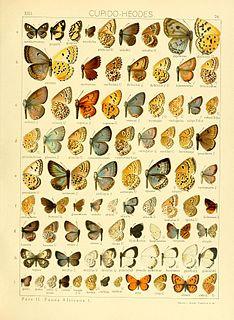
The Vitaceae are a family of flowering plants, with 14 genera and around 910 known species, including common plants such as grapevines and Virginia creeper. The family name is derived from the genus Vitis.

Caenorhabditis elegans is a free-living transparent nematode about 1 mm in length that lives in temperate soil environments. It is the type species of its genus. The name is a blend of the Greek caeno- (recent), rhabditis (rod-like) and Latin elegans (elegant). In 1900, Maupas initially named it Rhabditides elegans. Osche placed it in the subgenus Caenorhabditis in 1952, and in 1955, Dougherty raised Caenorhabditis to the status of genus.

Charles Gaudichaud-Beaupré was a French botanist.

Cissus is a genus of approximately 350 species of lianas in the grape family (Vitaceae). They have a cosmopolitan distribution, though the majority are to be found in the tropics.

Nekemias arborea, commonly known as pepper vine, is native to the Southeastern United States, Texas, and New Mexico. It spreads rapidly, climbing up trees and bushes. Although it is attractive, its rapid growth and ability to pull down trees makes it a nuisance if not strictly confined.

Eumorpha anchemolus, the anchemola sphinx moth, is a moth of the family Sphingidae. The species was first described by Pieter Cramer in 1780.

Eumorpha vitis, known as the vine sphinx, is a moth of the family Sphingidae.

Cissus or Kissos was a town of Amphaxitis, Macedon, not far from Rhaecelus, which appears to have been the name of the promontory where Aeneas legendarily founded his city. Cissus, along with Aeneia and Chalastra, contributed to the aggrandizement of Thessalonica. Cissus was the birthplace of Cisseus, a Thracian chief mentioned by Homer.

Cissus antarctica(synonym Cissus oblongata), called "kangaroo vine", is one of the best known species of the genus Cissus in the family of Vitaceae. It is a climbing plant, a vine, and comes from Australia.

Dendrosicyos is a monotypic genus in the plant family Cucurbitaceae. The only species is Dendrosicyos socotranus, the cucumber tree. The species is endemic to the island of Socotra in Yemen, and is the only species in the Cucurbitaceae to grow in a tree form. The species name was originally spelled D. socotrana, but this is corrected to masculine grammatical gender according to the International Code of Nomenclature for algae, fungi, and plants.

Cissus hypoglauca is a common Australian vine. It is one of the better known climbing plants of the genus Cissus in the grape family. A very common climber in moist areas of eastern Australia, it often colonises large areas after forest damage due to storms, fire or logging. Common names include jungle grape, water vine, giant water vine, five-leaf water vine, jungle vine, native grapes and billangai.

Cissus verticillata, the princess vine or seasonvine, is an evergreen perennial vine in the grapevine family Vitaceae.

Cissus quadrangularis is a perennial plant of the grape family. It is commonly known as veldt grape, devil's backbone, adamant creeper, asthisamharaka, hadjod and pirandai. The species is native to tropical Asia, Arabia and much of Africa.

Cupidopsis cissus, the common meadow blue, is a butterfly of the family Lycaenidae. It is found in most of Africa, south of the Sahara.
Cissus adnata is a woody vine species in the genus Cissus found in Asia and Australia.
Benjamin Kwakye is a Ghanaian novelist and lawyer. His first novel, The Clothes of Nakedness, won the 1999 Commonwealth Writers' Prize, best first book, Africa, and has been adapted for radio as a BBC Play of the Week. His novel The Sun by Night won the 2006 Commonwealth Writers' Prize, Best Book Africa. His novel The Other Crucifix won the 2011 IPPY award.

Cissus subaphylla is a low shrub in the grape family Vitaceae. It is endemic to the Yemeni island of Socotra. The plant grows mainly in dry, low-lying areas on alluvial fans or on limestone slopes, and is rarely found above elevations of 300 metres (980 ft), where it is replaced by C. hamaderohensis. It does not have the climbing habit of other Cissus species, and its stems are flattened and gray-green in colour, with relatively small leaves and flowers. The tangled mats of C. subaphylla stems act as a protective covering for plants regularly eaten by goats and other browsing animals; the plant is thus important in the rehabilitation of species such as Dendrosicyos, Maerua and Commiphora.
Ciscissus or Kiskisos was a town and bishopric of ancient Cappadocia. In Roman and Byzantine times the town's name was sometimes shortened to Cissus and belonged to the Roman province of Cappadocia Prima. It became a Christian bishopric, a suffragan of the metropolitan see of Caesarea in Cappadocia, the capital of the province. The names of two of its bishops are known from extant contemporary documents: Plato was at the Trullan Council of 692, and Soterichus at the Second Council of Nicaea in 787. No longer a residential bishopric, Ciscissus is today listed by the Catholic Church as a titular see.














